Building Performance under Untypical Weather Conditions: A 40-Year Study of Hong Kong
Abstract
:1. Introduction
2. Methodology
2.1. Differences between Yearly and Long-Term Weather Conditions
2.2. Identifying the Weather Conditions
- Extreme weather years (EWY) that take the highest positive or negative WS values.
- Near-extreme weather years (N-EWY) that take the highest positive or negative WS values, excluding the outliers.
- Common warm and cold years (CY) with the absolute of their positive or negative WS values that are (or closest to) the absolute WS values over the period under consideration.
- TMY takes the least absolute WST as a reference for various weather conditions.
2.3. The Typical Building for Weather Data Testing
3. Results
3.1. Differences between Yearly and Long-Term Weather Conditions
3.2. Building Cooling Demands in Various Weather Conditions
4. Conclusions
Author Contributions
Funding
Data Availability Statement
Conflicts of Interest
References
- Zhu, H.-C.; Ren, C.; Cao, S.-J. Fast prediction for multi-parameters (concentration, temperature and humidity) of indoor environment towards the online control of HVAC system. Build. Simul. 2021, 14, 649–665. [Google Scholar] [CrossRef]
- Yuan, X.; Pan, Y.; Yang, J.; Wang, W.; Huang, Z. Study on the application of reinforcement learning in the operation optimization of HVAC system. Build. Simul. 2021, 14, 75–87. [Google Scholar] [CrossRef]
- Wang, R.; Lu, S.; Zhai, X.; Feng, W. The energy performance and passive survivability of high thermal insulation buildings in future climate scenarios. Build. Simul. 2022, 15, 1209–1225. [Google Scholar] [CrossRef]
- Kong, X.; Chang, Y.; Li, N.; Li, H.; Li, W. Comparison study of thermal comfort and energy saving under eight different ventilation modes for space heating. Build. Simul. 2022, 15, 1323–1337. [Google Scholar] [CrossRef]
- Hong, X.; Shi, F.; Wang, S.; Yang, X.; Yang, Y. Multi-objective optimization of thermochromic glazing based on daylight and energy performance evaluation. Build. Simul. 2021, 14, 1685–1695. [Google Scholar] [CrossRef]
- Yan, D.; Zhou, X.; An, J.; Kang, X.; Bu, F.; Chen, Y.; Pan, Y.; Gao, Y.; Zhang, Q.; Zhou, H.; et al. DeST 3.0: A new-generation building performance simulation platform. In Building Simulation; Tsinghua University Press: Beijing, China, 2022. [Google Scholar]
- Hosseini, M.; Bigtashi, A.; Lee, B. Generating future weather files under climate change scenarios to support building energy simulation—A machine learning approach. Energy Build. 2021, 230, 110543. [Google Scholar] [CrossRef]
- González, G.; Ruiz, R.; Bandera, F.C. Impact of Actual Weather Datasets for Calibrating White-Box Building Energy Models Base on Monitored Data. Energies 2021, 14, 1187. [Google Scholar] [CrossRef]
- Su, F.; Fu, D.; Yan, F.; Xiao, H.; Pan, T.; Xiao, Y.; Kang, L.; Zhou, C.; Meadows, M.; Lyne, V.; et al. Rapid greening response of China’s 2020 spring vegetation to COVID-19 restrictions: Implications for climate change. Sci. Adv. 2021, 7, eabe8044. [Google Scholar] [CrossRef]
- Wang, D.; Li, Y.; Zhou, G.; Gu, E.; Xia, R.; Yan, B.; Yao, J.; Zhu, H.; Lu, X.; Yip, H.-L.; et al. High-performance see-through power windows. Energy Environ. Sci. 2022, 15, 2629–2637. [Google Scholar] [CrossRef]
- Ma, R.; Jiang, X.; Fu, J.; Zhu, T.; Yan, C.; Wu, K.; Müller-Buschbaum, P.; Li, G. Revealing the underlying solvent effect on film morphology in high-efficiency organic solar cells through combined ex situ and in situ observations. Energy Environ. Sci. 2023, 16, 2316–2326. [Google Scholar] [CrossRef]
- Fan, X.; Chen, B.; Wang, S.; Zhao, J.R.; Sun, H.J. An improved typical meteorological year based on outdoor climate comprehensive description method. Build. Environ. 2021, 206, 108366. [Google Scholar] [CrossRef]
- Hui, S.C.; Lam, J.C. Test reference year for comparative energy study. Hong Kong Eng. 1992, 20, 13–16. [Google Scholar]
- Hall, I.J.; Prairie, R.R.; Anderson, H.E.; Boes, E.C. Generation of a Typical Meteorological Year; Sandia Labs.: Albuquerque, NM, USA, 1978. [Google Scholar]
- ASHRAE. Weather Year for Energy Calculations; American Society of Heating, Refrigeratingand Air-Conditioning Engineers: Atlanta, GA, USA, 1985. [Google Scholar]
- Fangting, S.; Qunfei, Z.; Ruhong, W.; Yi, J.; Anyuan, X.; Bomin, W.; Yanjun, Z.; Qingxiang, L. Meteorological data set for building thermal environment analysis of China. In Proceedings of the 10th international Building Performance Simulation Association Conference and Exhibition, Beijing, China, 3–6 September 2007. [Google Scholar]
- Wu, X.; Wang, L.; Yao, R.; Luo, M.; Li, X. Identifying the dominant driving factors of heat waves in the North China Plain. Atmos. Res. 2021, 252, 105458. [Google Scholar] [CrossRef]
- Liu, S.; Kwok, Y.-T.; Lau, K.; Ng, E. Applicability of different extreme weather datasets for assessing indoor overheating risks of residential buildings in a subtropical high-density city. Build. Environ. 2021, 194, 107711. [Google Scholar] [CrossRef]
- Crawley, D.B.; Lawrie, L.K. Rethinking the tmy: Is the ‘typical’ meteorological year best for building performance simulation? In Proceedings of the 14th Conference of International Building Performance Simulation Association, Hyderabad, India, 7–9 December 2015. [Google Scholar]
- Hacker, J.; Belcher, S.; White, A. TM49 Design Summer Years for London; CIBSE: London, UK, 2014. [Google Scholar]
- Watkins, R.; Levermore, G.J.; Parkinson, J.B. The design reference year—A new approach to testing a building in more extreme weather using UKCP09 projections. Build. Serv. Eng. Res. Technol. 2012, 34, 165–176. [Google Scholar] [CrossRef]
- Liu, C.; Kershaw, T.; Eames, M.E.; Coley, D.A. Future probabilistic hot summer years for overheating risk assessments. Build. Environ. 2016, 105, 56–68. [Google Scholar] [CrossRef]
- Jentsch, M.F.; Eames, M.E.; Levermore, G.J. Generating near-extreme Summer Reference Years for building performance simulation. Build. Serv. Eng. Res. Technol. 2015, 36, 701–727. [Google Scholar] [CrossRef]
- Guo, S.; Yan, D.; Hong, T.; Xiao, C.; Cui, Y. A novel approach for selecting typical hot-year (THY) weather data. Appl. Energy 2019, 242, 1634–1648. [Google Scholar] [CrossRef]
- Piotr, N.; Marcin, J.; Dariusz, H. Comparison of untypical meteorological years (UMY) and their influence on building energy performance simulations. In Proceedings of the 13th Conference of International Building Performance Simulation Association, Chambéry, France, 25–28 August 2013. [Google Scholar]
- Nik, V.M. Making energy simulation easier for future climate—Synthesizing typical and extreme weather data sets out of regional climate models (RCMs). Appl. Energy 2016, 177, 204–226. [Google Scholar] [CrossRef]
- Moazami, A.; Nik, V.M.; Carlucci, S.; Geving, S. Impacts of future weather data typology on building energy performance—Investigating long-term patterns of climate change and extreme weather conditions. Appl. Energy 2019, 238, 696–720. [Google Scholar] [CrossRef]
- Nik, V.M. Application of typical and extreme weather data sets in the hygrothermal simulation of building components for future climate—A case study for a wooden frame wall. Energy Build. 2017, 154, 30–45. [Google Scholar] [CrossRef]
- Lam, J.C.; Hui, S.C.M. Outdoor design conditions for HVAC system design and energy estimation for buildings in Hong Kong. Energy Build. 1995, 22, 25–43. [Google Scholar] [CrossRef]
- Zou, Y.; Xiang, K.; Zhan, Q.; Li, Z. A simulation-based method to predict the life cycle energy performance of residential buildings in different climate zones of China. Build. Environ. 2021, 193, 107663. [Google Scholar] [CrossRef]
- Zou, Y.; Lou, S.; Xia, D.; Lun, I.Y.F.; Yin, J. Multi-objective building design optimization considering the effects of long-term climate change. J. Build. Eng. 2021, 44, 102904. [Google Scholar] [CrossRef]
- Li, D.H.W.; Lou, S.W.; Lam, J.C. An Analysis of Global, Direct and Diffuse Solar Radiation. Energy Procedia 2015, 75, 388–393. [Google Scholar] [CrossRef]
- Finkelstein, J.M.; Schafer, R.E. Improved Goodness-of-Fit Tests. Biometrika 1971, 58, 641–645. [Google Scholar] [CrossRef]
- HK Building Authority. Code of Practice for Overall Thermal Transfer Value in Buildings; HK Building Authority: Hong Kong, China, 1995. [Google Scholar]
- Huang, Y.; Niu, J.-L. Energy and visual performance of the silica aerogel glazing system in commercial buildings of Hong Kong. Constr. Build. Mater. 2015, 94, 57–72. [Google Scholar] [CrossRef]
- Huang, Y.; Niu, J.-L. Application of super-insulating translucent silica aerogel glazing system on commercial building envelope of humid subtropical climates—Impact on space cooling load. Energy 2015, 83, 316–325. [Google Scholar] [CrossRef]
- Lou, S.; Li, D.H.W.; Huang, Y.; Zhou, X.; Xia, D.; Zhao, Y. Change of climate data over 37 years in Hong Kong and the implications on the simulation-based building energy evaluations. Energy Build. 2020, 222, 110062. [Google Scholar] [CrossRef]
- EMSD. Performance-Based Building Energy Code; Electrical & Mechanical Services Department: Hong Kong, China, 2007. [Google Scholar]
- Liu, S.; Kwok, Y.T.; Lau, K.K.-L.; Tong, H.W.; Chan, P.W.; Ng, E. Development and application of future design weather data for evaluating the building thermal-energy performance in subtropical Hong Kong. Energy Build. 2020, 209, 109696. [Google Scholar] [CrossRef]
- Crawley, D.B.; Lawrie, L.K.; Winkelmann, F.C.; Buhl, W.F.; Huang, Y.J.; Pedersen, C.O.; Strand, R.K.; Liesen, R.J.; Fisher, D.E.; Witte, M.J.; et al. EnergyPlus: Creating a new-generation building energy simulation program. Energy Build. 2001, 33, 319–331. [Google Scholar] [CrossRef]


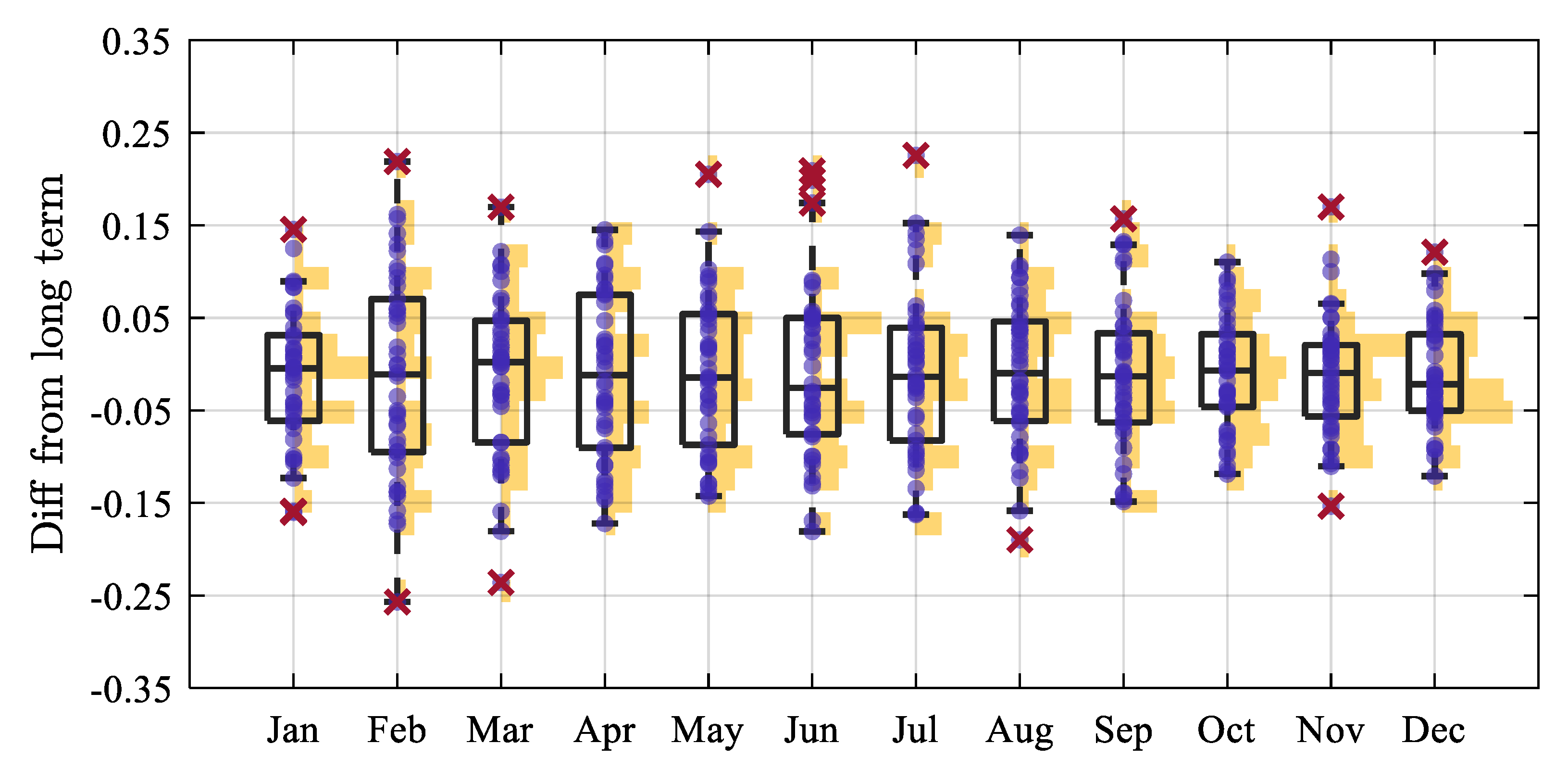
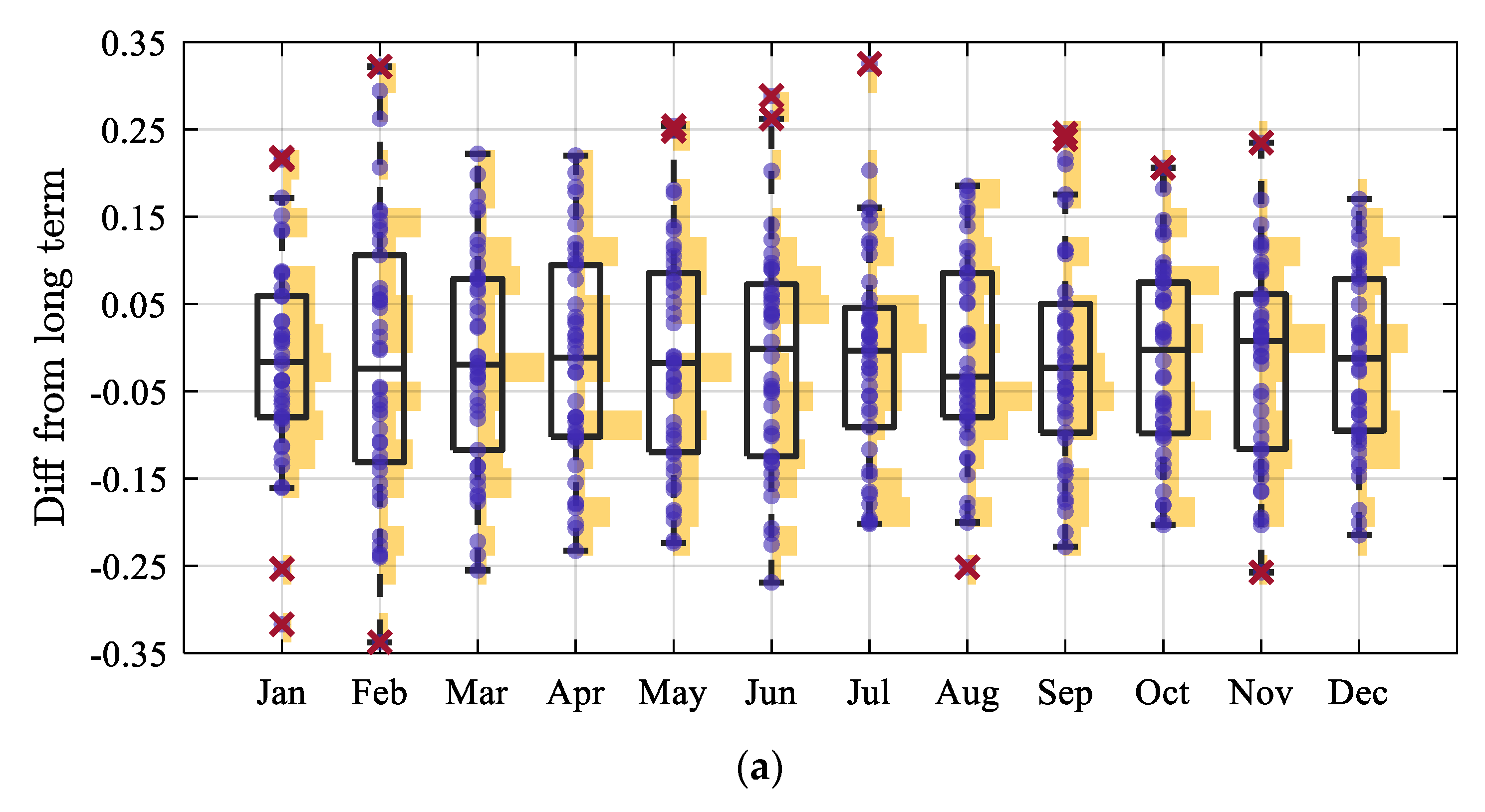

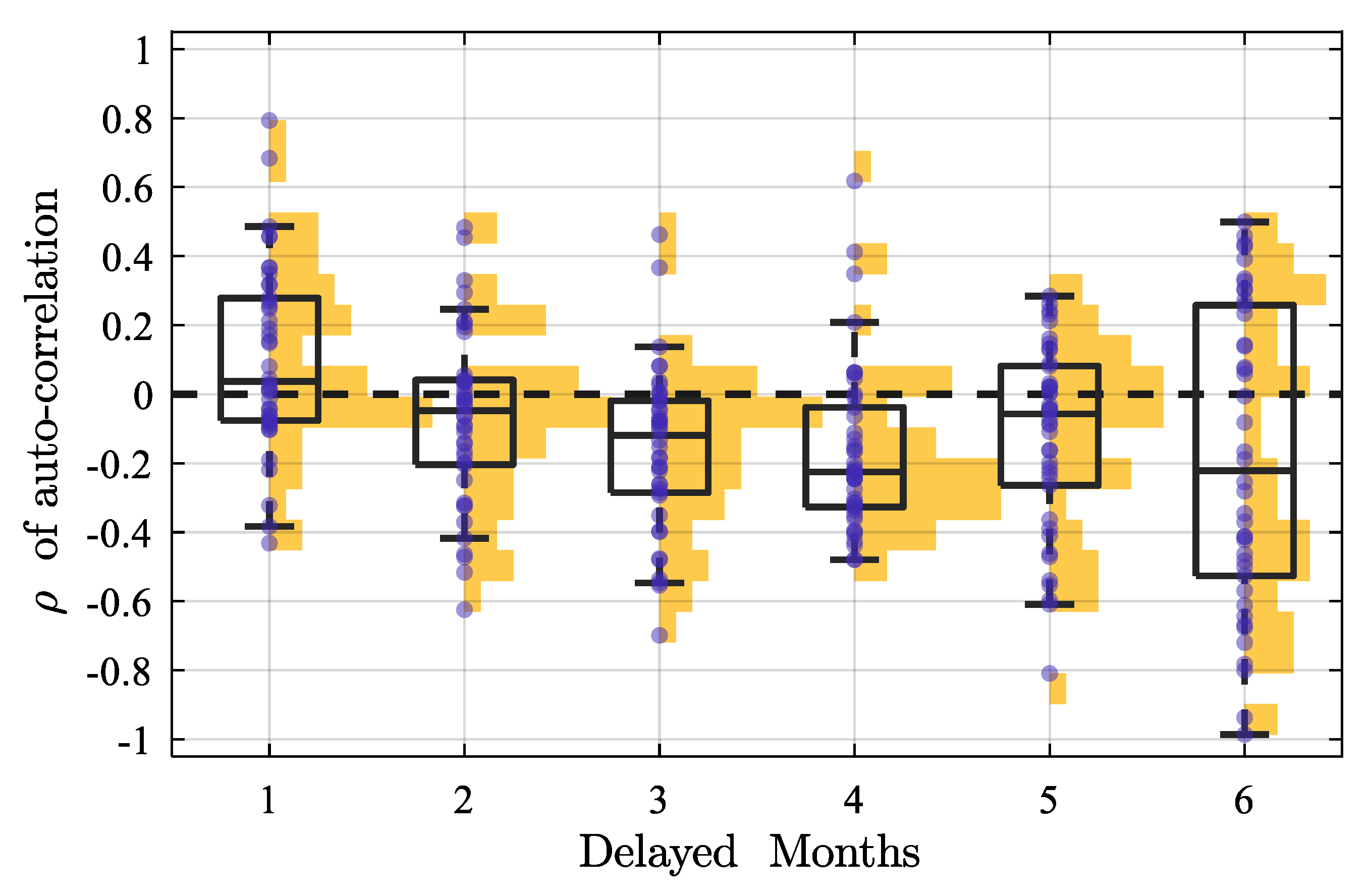
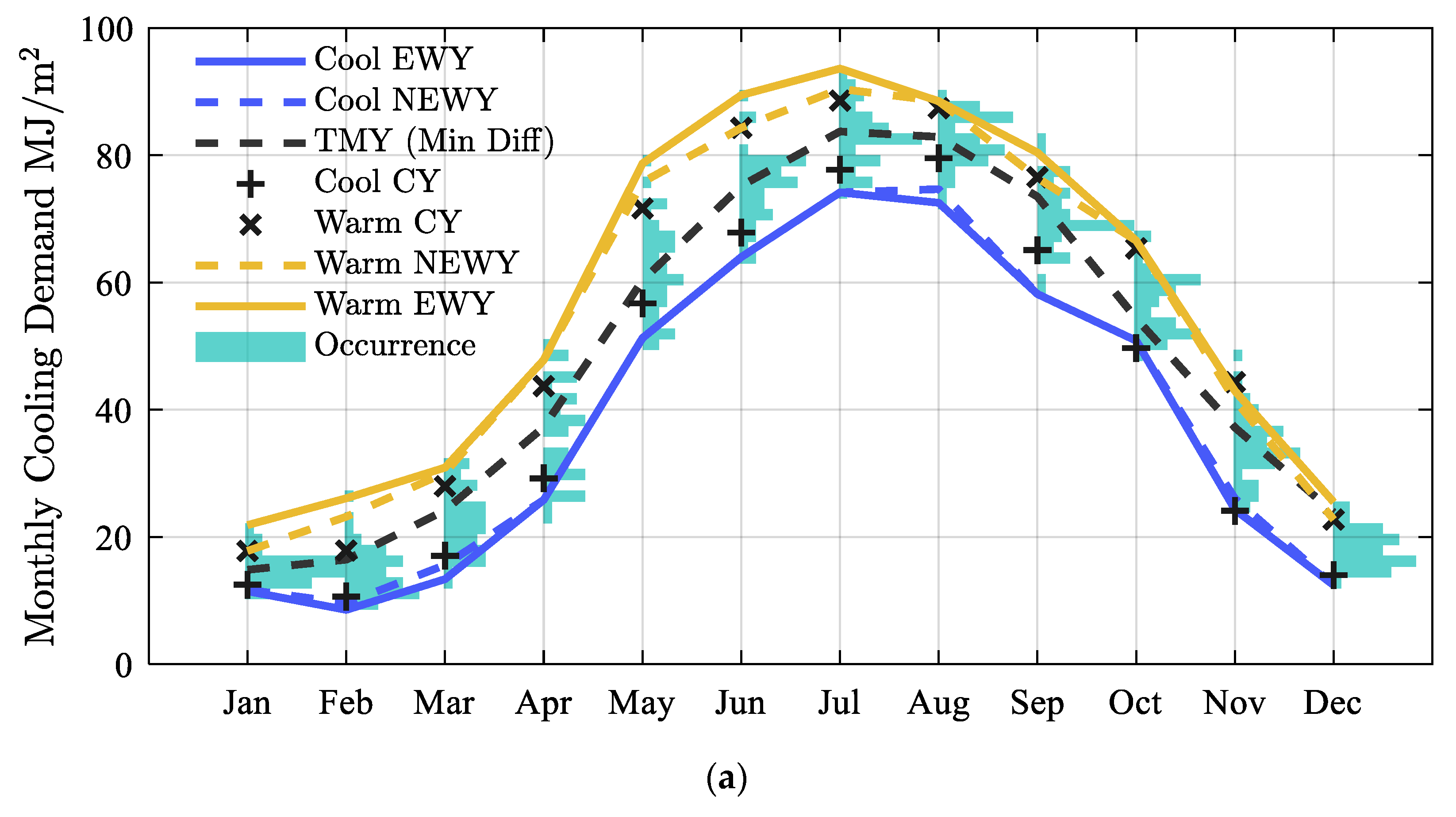
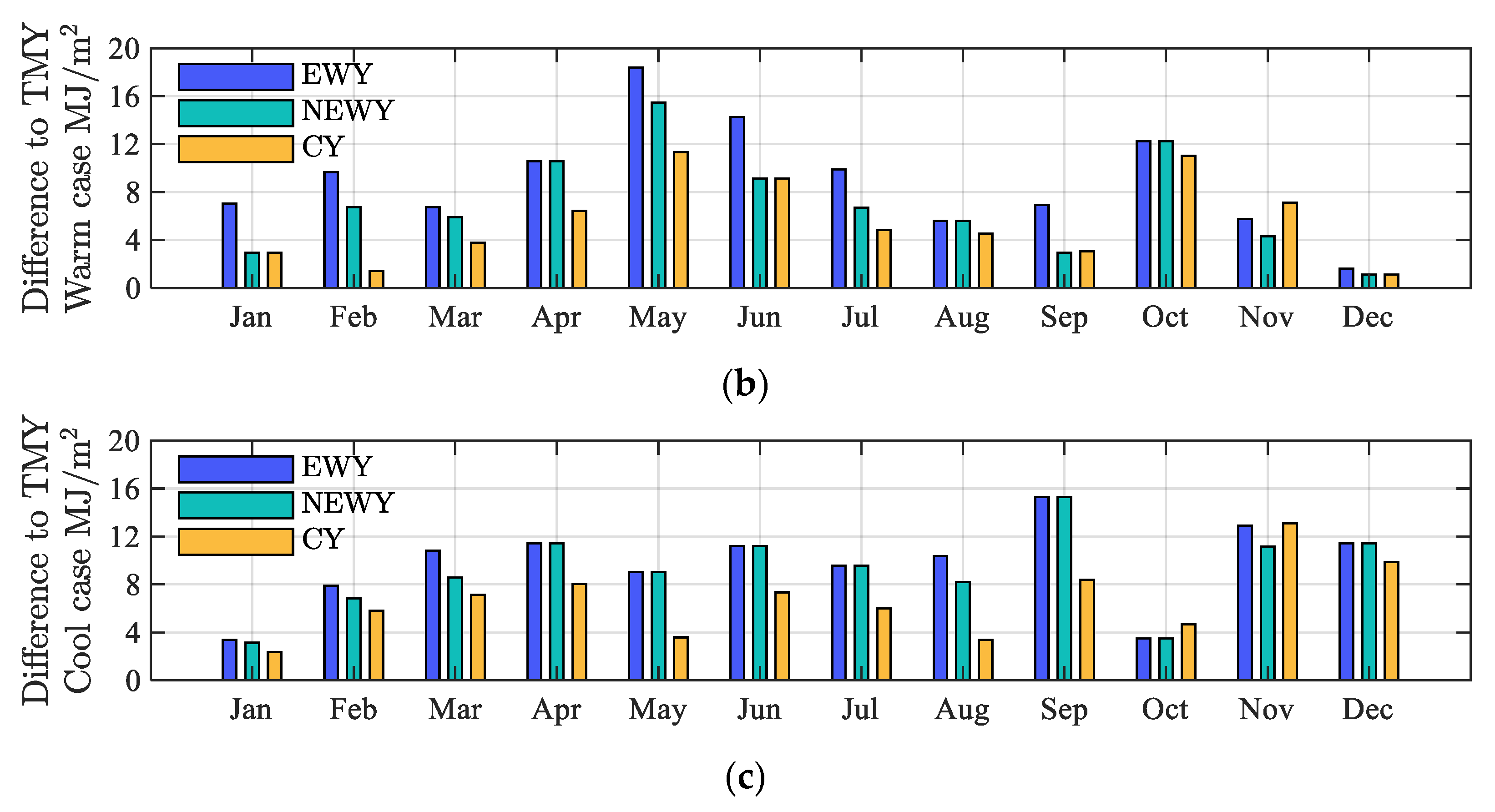
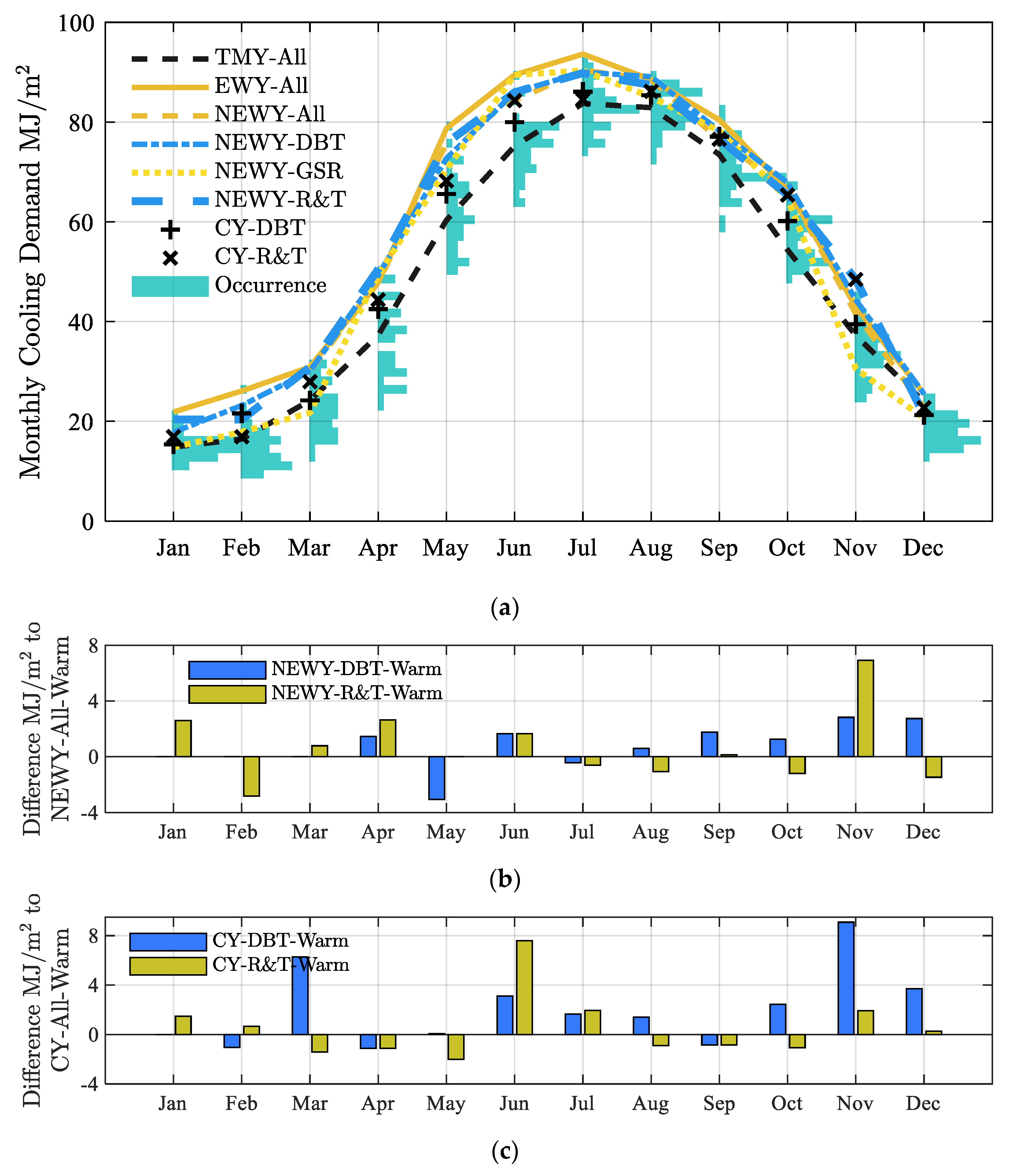

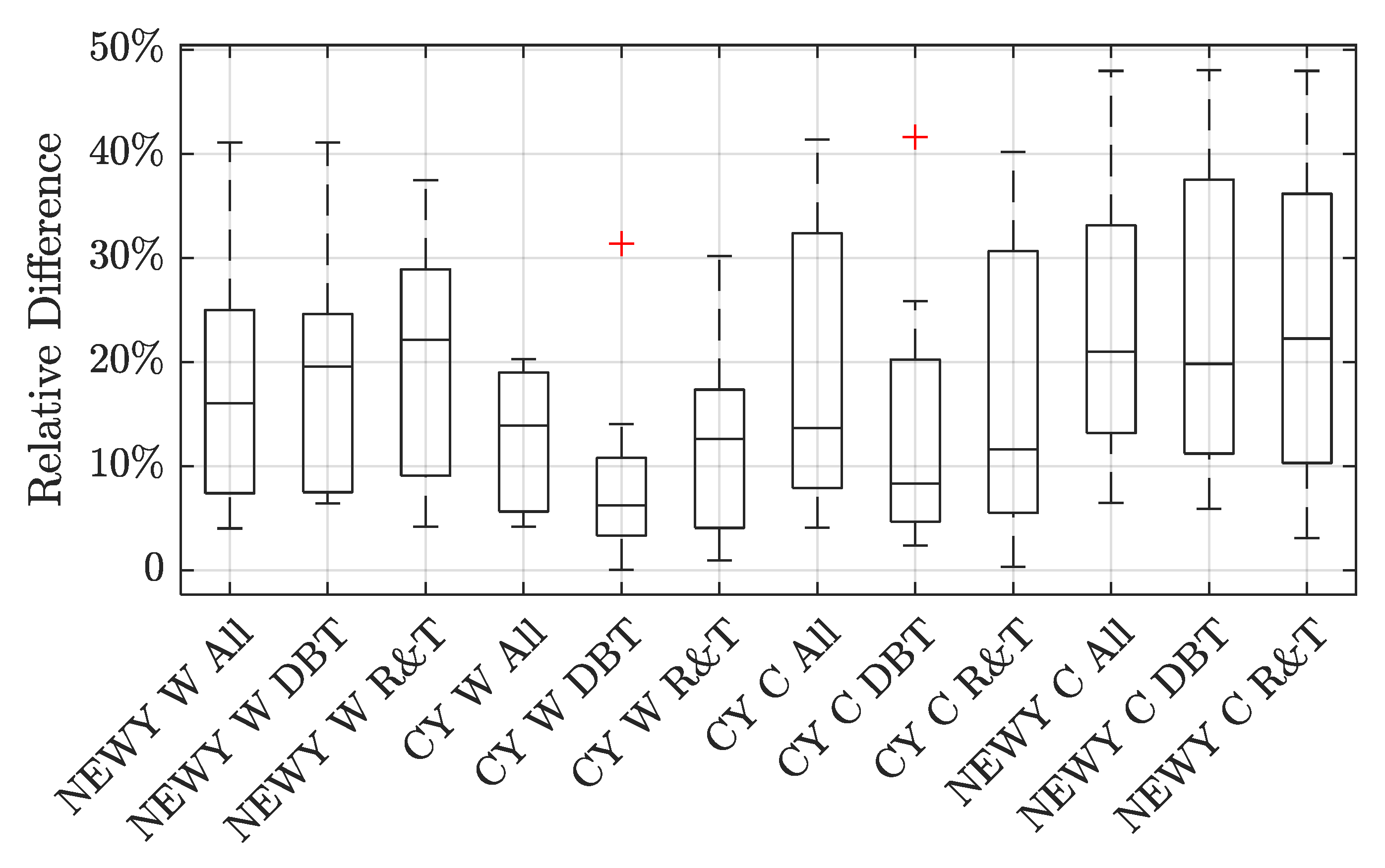
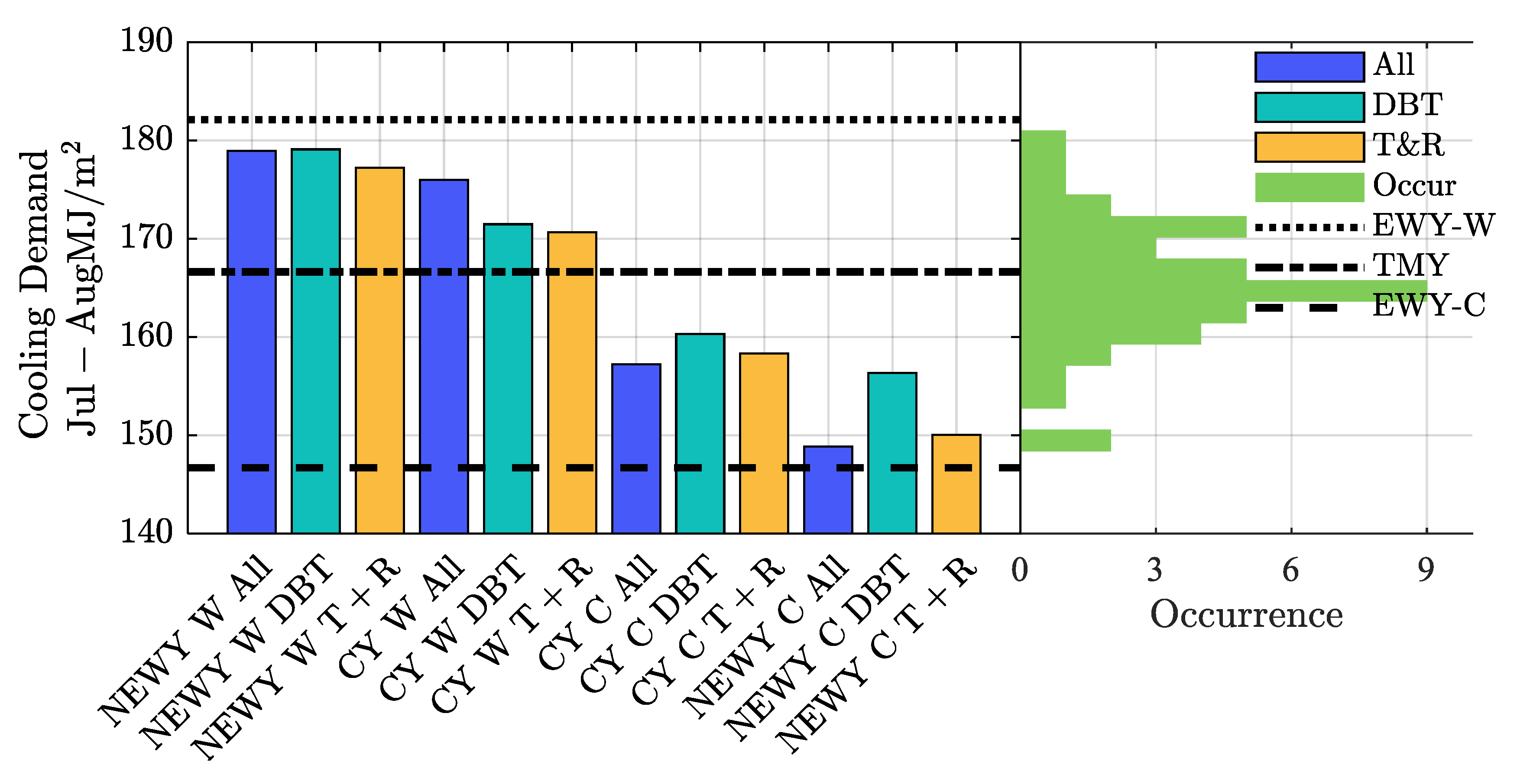
| DBT | DPT | WS | GSR | ||||||
|---|---|---|---|---|---|---|---|---|---|
| Max | Min | Avg | Max | Min | Avg | Max | Avg | ||
| All | 5% | 5% | 30% | 2.5% | 2.5% | 5% | 5% | 5% | 40% |
| GSR-only | - | - | - | - | - | - | - | - | 100% |
| DBT-only | 12.5 | 12.5% | 75% | - | - | - | - | - | - |
| GSR+DBT | 6.25% | 6.25% | 37.5% | - | - | - | - | - | 50% |
| Area Type | Floor Area per Person (m2/Person) | Fresh Air (L/s/Person) | Artificial Lighting (W/m2) | Equipment (W/m2) | Infiltration Rate (Air Change per Hour) |
|---|---|---|---|---|---|
| Office | 8 | 8 | 15 | 25 | 1.4 |
| Mall | 5 | 10 | 15 | 10 | 1.4 |
| Material | (A) Wall | (B) Roof | ||||||||
|---|---|---|---|---|---|---|---|---|---|---|
| Mosaic Tile | Cement Render | Concrete Panel | Gypsum Plaster | Concrete Tiles | Asphalt | Cement Screed | Expanded Polystyrene | Concrete | Gypsum Plaster | |
| Thickness (m) | 0.005 | 0.01 | 0.1 | 0.01 | 0.025 | 0.02 | 0.05 | 0.05 | 0.15 | 0.01 |
| Conductivity (W/m K) | 1.5 | 0.72 | 2.16 | 0.51 | 1.1 | 1.2 | 0.72 | 0.035 | 2.16 | 0.51 |
| Specific heat (J/kg K) | 840 | 840 | 657 | 960 | 657 | 1700 | 840 | 1470 | 657 | 960 |
| Density (kg/m3) | 2500 | 1860 | 2400 | 1120 | 2100 | 2300 | 1860 | 23 | 2400 | 1120 |
| (C) Window | ||||||||||
| Thermal properties | Thermal conductivity (W/m K) | Transmittance | Reflectance (both sides) | |||||||
| Solar | Visible | Solar | Visible | |||||||
| Values | 1 W/(m K) | 0.834 | 0.899 | 0.075 | 0.083 | |||||
Disclaimer/Publisher’s Note: The statements, opinions and data contained in all publications are solely those of the individual author(s) and contributor(s) and not of MDPI and/or the editor(s). MDPI and/or the editor(s) disclaim responsibility for any injury to people or property resulting from any ideas, methods, instructions or products referred to in the content. |
© 2023 by the authors. Licensee MDPI, Basel, Switzerland. This article is an open access article distributed under the terms and conditions of the Creative Commons Attribution (CC BY) license (https://creativecommons.org/licenses/by/4.0/).
Share and Cite
Lou, S.; Peng, Z.; Cai, J.; Zou, Y.; Huang, Y. Building Performance under Untypical Weather Conditions: A 40-Year Study of Hong Kong. Buildings 2023, 13, 2587. https://doi.org/10.3390/buildings13102587
Lou S, Peng Z, Cai J, Zou Y, Huang Y. Building Performance under Untypical Weather Conditions: A 40-Year Study of Hong Kong. Buildings. 2023; 13(10):2587. https://doi.org/10.3390/buildings13102587
Chicago/Turabian StyleLou, Siwei, Zhengjie Peng, Jilong Cai, Yukai Zou, and Yu Huang. 2023. "Building Performance under Untypical Weather Conditions: A 40-Year Study of Hong Kong" Buildings 13, no. 10: 2587. https://doi.org/10.3390/buildings13102587





